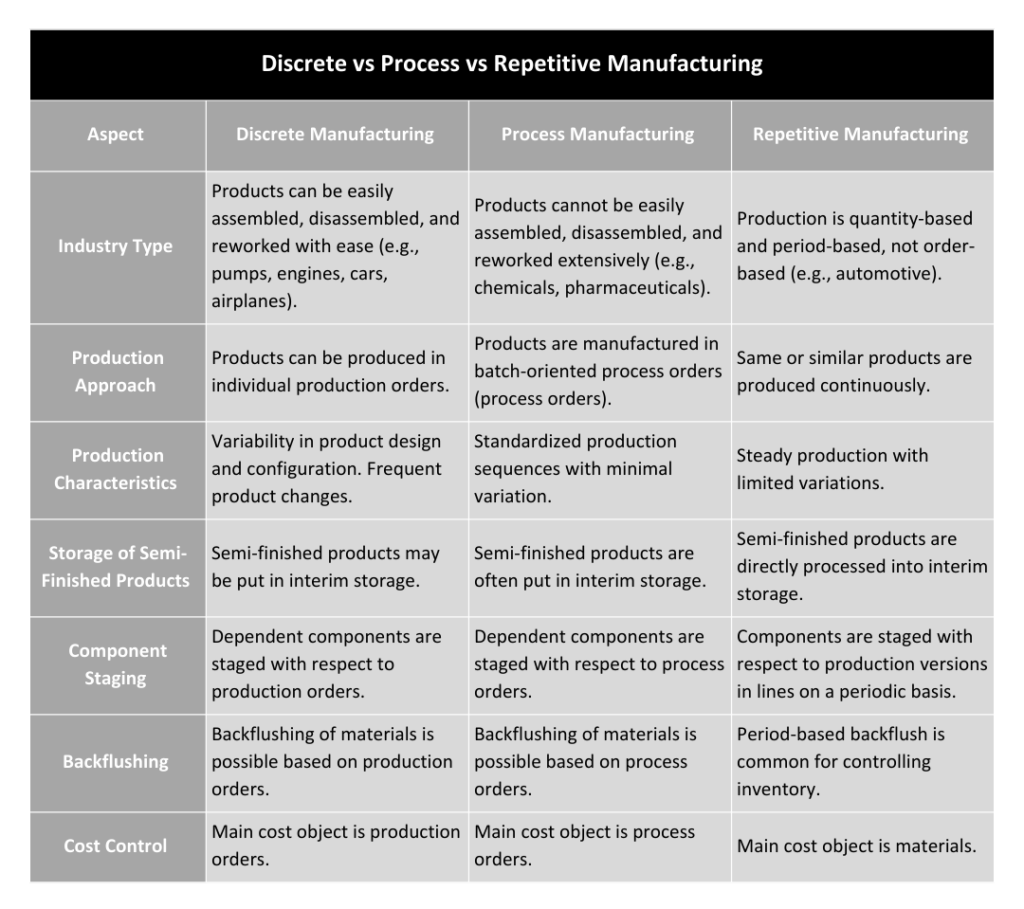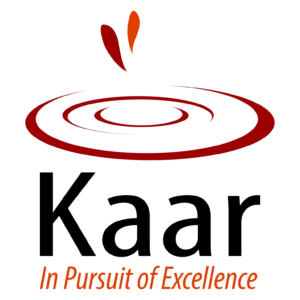Introduction
In the world of manufacturing, SAP Production Planning (SAP PP) plays a pivotal role in optimizing processes, streamlining operations, and enhancing overall productivity. One of the fundamental decisions that manufacturers need to make within SAP PP is choosing the right manufacturing strategy, which typically falls under three categories. Each approach has its unique characteristics and is tailored to different types of production scenarios.
In this blog, we will delve into Discrete vs Repetitive vs Process Manufacturing in SAP PP, their key distinctions and considerations when implementing these manufacturing strategies in SAP PP.
The three main types of manufacturing processes in SAP PP are as follows:
➔ Discrete Manufacturing
➔ Process Manufacturing
➔ Repetitive Manufacturing
- Discrete Manufacturing
Discrete manufacturing in SAP PP is primarily used for producing individual or distinct items. This approach is ideal for businesses that manufacture customizable products with variations in materials, components, and order specifications. Key features of discrete manufacturing in SAP PP include:
Bill of Materials (BOM): Discrete manufacturing relies on detailed BOMs that specify the components required for each product configuration.
Work Orders: Work orders are used to plan and control production for specific products or product variants.
Make-to-Order (MTO): Discrete manufacturing is well-suited for MTO production scenarios where items are produced based on customer orders.
High Variability: The approach accommodates high product variability and frequent changes in production.
- Repetitive Manufacturing
Repetitive manufacturing in SAP PP is characterized by the production of the same or similar products in a continuous or repetitive manner. It is commonly used for high-volume, standardized production. Key features of repetitive manufacturing in SAP PP include:
Production Versions: Repetitive manufacturing employs production versions to define the production quantities, rates, and schedules.
Master Production Schedules (MPS): A steady production flow is maintained based on fixed schedules and quantities.
Make-to-Stock (MTS): Repetitive manufacturing is well-suited for MTS scenarios, where products are produced and stocked in anticipation of customer demand.
Minimal Variability: This approach works best when products have minimal variations and standardization is key.
- Process Manufacturing
Process manufacturing in SAP PP is tailored for industries where products are manufactured through mixing, blending, and chemical reactions. This approach is common in industries such as pharmaceuticals, chemicals, and food processing. Key features of process manufacturing in SAP PP include:
Recipe Management: Process manufacturing uses recipes or formulas to define the ingredients, quantities, and production sequences.
Batch Production: Products are produced in batches, and the focus is on quality control and adherence to precise recipes.
Lot Traceability: Process manufacturing places a high emphasis on lot traceability for quality control and regulatory compliance.
Continuous Improvement: Continuous process improvement is crucial to enhance product consistency and quality.
Discrete vs Repetitive vs Process manufacturing

Choosing the Right Strategy
Selecting the right manufacturing strategy within SAP PP is critical for operational efficiency and customer satisfaction. The choice between discrete, repetitive, and process manufacturing largely depends on your industry, product type, and production methods. Consider the following factors when making this decision:
➔ Product Type: Determine whether your products are customizable, standardized, or produced through continuous processes.
➔ Industry Requirements: Compliance and regulatory factors may influence your choice, especially in process manufacturing.
➔ Volume and Demand: Assess your production volumes and demand patterns to decide between MTO or MTS strategies.
By carefully considering your product type, industry-specific demands, and production volume, you can tailor SAP PP to meet your unique manufacturing needs. This, in turn, will drive operational excellence and ensure customer satisfaction.
Conclusion
SAP PP offers a robust set of tools and functionalities to support discrete, repetitive, and process manufacturing strategies. Understanding the nuances and requirements of each approach is crucial for effective production planning and execution. Whether you are producing customized goods, high-volume standardized products, or running continuous processes, SAP PP can be tailored to meet your specific manufacturing needs, driving operational excellence and ensuring customer satisfaction.
If you have any queries or need guidance on choosing the manufacturing strategy that better suits your company, our team of experts is here to provide personalized assistance and help you make the right decision.
Contact us by clicking here!
FAQ’s
What are the main SAP PP manufacturing types?
The main SAP PP manufacturing types are discrete, process, and repetitive manufacturing, each tailored to specific production scenarios based on industry and product characteristics.
How to choose the right SAP PP manufacturing strategy?
Choosing the right SAP PP manufacturing strategy depends on factors like your product type, industry requirements, and production volume, ensuring alignment with your specific manufacturing needs.
Differences between SAP PP Discrete, Process, and Repetitive?
Discrete manufacturing is for customizable products with variations and is adaptable to frequent changes in production, process manufacturing is prevalent in industries like pharmaceuticals, chemicals, and food processing, and repetitive manufacturing is best suited for high-volume, standardized production with minimal variations.
Which industries use SAP PP Process Manufacturing?
Industries such as pharmaceuticals, chemicals, and food processing commonly use SAP PP process manufacturing due to its focus on quality control, lot traceability, and adherence to regulatory standards.
